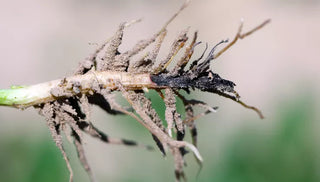Fungal root rots are common on bean plants. They typically cause reddish brown lesions on the roots. There are two types of root rot that affect beans:
- Fusarium
- Rhizoctonia
Fusarium root rot lesions can extend the entire length of the root. Plants try to compensate by producing side roots near the soil surface, but growth is stunted and yellow. Yields are generally poor. This fungus attacks green beans, but may also infect lima beans, Southern peas, and garden peas. Heavy, acidic soils with low fertility and a coarse texture are more likely to harbor fusarium root rot. In warm, wet weather, the fungus may infect young bean plants within weeks of germinating.
Rhizoctonia root rot primarily affects the seedlings of beans and related crops. Infected plants exhibit circular reddish brown lesions on roots. Severely infected seedlings snap off at the soil line. The fungus thrives in poorly drained soils and is more prevalent during periods of cool, wet weather. The disease can also infect bean pods later in the summer, where it causes similar reddish lesions.
Prevention and Control
- Minimize soil compaction and add compost to improve aeration. If your garden soil is heavy or wet, consider gardening in raised beds.
- Wait to plant warm-weather crops until after the soil has warmed to 55-60 degrees F.
- Avoid overwatering beans and related crops. Once seedlings are established, allow the top inch of soil to dry out between waterings.




